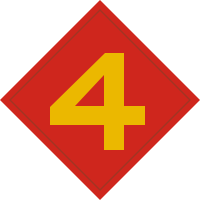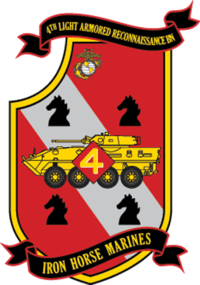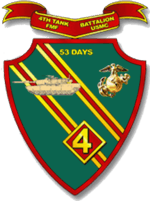4th Marine Division (United States)
| 4th Marine Division | |
|---|---|
|
4th Marine Division insignia | |
| Active |
August 14, 1943 – November 28, 1945 February 1966 – present |
| Allegiance |
|
| Branch |
|
| Type | Marine ground combat element forces |
| Role | Command and control organization containing three Marine regiments and several separate combat support battalions |
| Size | Marine Division (Approximately 17,000) |
| Part of | Marine Forces Reserve |
| Garrison/HQ | New Orleans, Louisiana |
| Nickname(s) | "Fighting Fourth" |
| Engagements |
Operation Desert Storm Operation Enduring Freedom Operation Iraqi Freedom |
The 4th Marine Division is a reserve division in the United States Marine Corps. It is the ground combat element of the Marine Forces Reserve and is headquartered in New Orleans, Louisiana and has units throughout the United States.
Mission
Provide trained combat and combat support personnel and units to augment and reinforce the active component in time of war, national emergency, and at other times as national security requires; and have the capability to reconstitute the Division, if required.
Subordinate units
-
 Headquarters Battalion[1]
Headquarters Battalion[1] -
 14th Marine Regiment
14th Marine Regiment -
 23rd Marine Regiment
23rd Marine Regiment -
 25th Marine Regiment
25th Marine Regiment -
 4th Assault Amphibian Battalion
4th Assault Amphibian Battalion -
 4th Combat Engineer Battalion
4th Combat Engineer Battalion -
 4th Light Armored Reconnaissance Battalion
4th Light Armored Reconnaissance Battalion -
 4th Reconnaissance Battalion
4th Reconnaissance Battalion -
 4th Tank Battalion
4th Tank Battalion -
 3rd Force Reconnaissance Company
3rd Force Reconnaissance Company -
_03.png) 4th Force Reconnaissance Company
4th Force Reconnaissance Company
The division's 24th Marine Regiment was deactivated in 2013.

History
World War II

This division was formed by the organization and redesignation of several other units. The 23rd Marine Regiment began as infantry detached from the 3rd Marine Division in February 1943, the same month that an artillery battalion of the 12th Marines became the genesis of the 14th Marines and engineer elements of the 19th Marines formed the nucleus of the 20th Marines. In March the 24th Marine Regiment was organized, and then in May it was split in two to supply the men for the 25th Marines.
This war-time shuffling provided the major building blocks for a new division. The units were originally separated, however, with the 24th Marines and a variety of reinforcing units (engineer, artillery, medical, motor transport, special weapons, tanks, etc.) at Camp Pendleton in California. The rest of the units were at Camp Lejeune, North Carolina. This East Coast echelon moved to Pendleton by train and transit of the Panama Canal in July and August. When all the units were finally together, the 4th Marine Division was formally activated on August 14, 1943, with Major General Harry Schmidt in command.
After intensive training, it shipped out on 13 January 1944, and in 13 months made four major amphibious assaults, in the battles of Kwajalein (Roi-Namur), Saipan, Tinian, and Iwo Jima, suffering more than 17,000 casualties. It was awarded two Presidential Unit Citations and a Navy Unit Commendation, and then deactivated 28 November 1945.
The division patch worn on Saipan had a gold "4" on a scarlet background, the official colors of the U.S. Marine Corps. The emblem was designed by SSgt John Fabion, a member of the Division's Public Affairs Office before the Marshalls Campaign. His commanding officer was astonished to find that when the Division attacked Roi Islet in Kwajelein Atoll in the Marshall Islands (January 1944), the layout of the runways on the airstrip there were an exact replica of the "4".
Division commanders
- Major General Harry Schmidt (18 August 1943 – 11 July 1944)
- Major General Clifton B. Cates (12 July 1944 – November 1945)
Assistant division commanders
- Brigadier General James L. Underhill (18 August 1943 – 10 April 1944)
- Brigadier General Samuel C. Cumming (11 April 1944 – 29 August 1944)
- Brigadier General Franklin A. Hart (30 August 1944 – September 1945)
Chiefs of Staff
- Colonel William W. Rogers (14 August 1943 - 10 August 1944)
- Colonel Matthew C. Horner (21 August 1944 - 29 August 1944)
- Brigadier General Franklin A. Hart (30 August 1944 - 31 October 1944) (Served simultaneously as Assistant Division Commander)
- Colonel Merton J. Batchelder (1 November 1944 - 9 April 1945)
- Colonel Walter W. Wensinger (10 April 1945 - 16 April 1945)
- Colonel Edwin A. Pollock (17 April 1945 - 28 November 1945)
Reactivation

In February 1966, it was reactivated as the only division in the Marine Forces Reserve.[2]
Background: Early in 1962, Secretary of Defense Robert S. McNamara indicated to the Congress that he wanted the Marine Corps to have a fourth division/wing team, to be formed of Ready Reserves. In April of that year, the Commandant of the Marine Corps announced a major reorganization of the Marine Corps Reserve to be effective 1 July 1962. In this reorganization, 53 reserve units were redesignated as 4th Marine Division units. While 1 July 1962 is regarded as the date of reactivation of the division, it was not until 14 February 1966 that the 4th Marine Division headquarters nucleus was actually activated at Camp Pendleton. The division was given the primary mission "to establish an effective staff nucleus capable of directing, controlling and integrating, as directed, the mobilization planning and logistics functions preceding the activation of the 4th Marine Division and of ensuring an orderly and efficient mobilization of the division." Major General Robert E. Cushman, Jr., commanding general of Camp Pendleton was given the additional responsibility as the commanding general of the division.[3]
On 23 June 1966, the World War II division colors were presented to General Cushman, significantly at a 4th Marine Division Association meeting at Camp Pendleton, California. Reminiscent of a passed torch, a new generation of Marines was eager to prove itself worthy of the trust attendant in the acceptance of the proud colors.[3]
Even before the headquarters nucleus had been formed, still other changes were on the drawing board. In late 1965, the Commandant approved a plan to further reorganize the Organized Marine Corps Reserve so that the division/wing team would become a "mirror image" of its regular counterparts. The first step toward achieving this goal was to reorganize the 4th Marine Aircraft Wing so that it would reflect an active wing. Other steps that were required to accomplish the Commandant's directive were: establish division combat and combat support units together with certain force troops units; form the 4th Force Service Regiment (completed in June 1968); and form FMF augmentation units. To complete the reorganization, active, duty colonels were assigned as commanders of the reserve regiments, reserve brigadier generals were assigned as assistant division commanders, and an active duty general officer was assigned as a full-time division commander. All of these changes were made by 15 July 1970 when Brigadier General Leo J. Dulacki arrived to take command of the division. One month later, General Dulacki was promoted to major general. The "nucleus" designation was dropped with the command unit now being designated as Headquarters, 4th Marine Division.[3]

With the division's new structure came a new mission. The division was now responsible for training all Organized Marine Corps Reserve ground units. The Commandant's intent of 1965 had been accomplished and the Marine Corps had one more division/wing team. The new change antedated by three years the "Total Force Concept," the Department of Defense policy of integrating reserve component units into the wartime planning and programming process.[3]
The 4th Marine Division was now a fully structured force cn its own right, able to muster and move out to a combat assignment within a relatively short period of time. In still another change, effective 17 May 1976, the 4th Division Support Group was formed, providing the division with selective combat service support which includes combat engineers, tactical motor transport, and an assault shore party. In a move external to the division, certain battalions were added to the 4th Force Service Regiment, now redesignated as the 4th Force Service Support Group.[3]
The ultimate goal of any Marine division is readiness, but the 4th Marine Division has one peculiar problem not shared with the regular divisions. An unusual span of control situation is brought about by the geographic dispersion of some 200 division units throughout the United States. The training accomplishments of the 4th Marine Division have been both imaginative in content and impressive in operation.[3]
The 4th Marine Division has one purpose and that was clearly expressed by Major General Edward J. Miller in his 1976 Armed Forces Day message, "The 4th Marine Division stands ready to carry out any mission assigned as the Marine Corps' Force in Readiness." Created for battle in 1943, the division's ultimate purpose remains the same.[3]
Unit awards
A unit citation or commendation is an award bestowed upon an organization for the action cited. Members of the unit who participated in said actions are allowed to wear on their uniforms the awarded unit citation. The 4th Marine Division has been presented with the following awards:
| Presidential Unit Citation with two bronze stars | |
| Navy Unit Commendation with one bronze star | |
| Asiatic-Pacific Campaign Medal with four bronze stars | |
| World War II Victory Medal | |
| National Defense Service Medal with two bronze stars | |
| Southwest Asia Service Medal | |
| Global War on Terrorism Service Medal |
 Presidential Unit Citation (World War II)(I MEF Iraq 2003)
Presidential Unit Citation (World War II)(I MEF Iraq 2003) Navy Unit Commendation with three Bronze Stars (World War II, Desert Storm, I MEF Iraq 2004, II MEF Iraq 2007)
Navy Unit Commendation with three Bronze Stars (World War II, Desert Storm, I MEF Iraq 2004, II MEF Iraq 2007) National Defense Medal with two Bronze Stars (Desert Storm, War on Terror)
National Defense Medal with two Bronze Stars (Desert Storm, War on Terror) Asiatic-Pacific Campaign Medal with four Bronze Stars (World War II)
Asiatic-Pacific Campaign Medal with four Bronze Stars (World War II) World War II Victory Medal
World War II Victory Medal Southwest Asia Service Medal with two Bronze Stars (Desert Shield, Desert Storm)
Southwest Asia Service Medal with two Bronze Stars (Desert Shield, Desert Storm) Global War on Terrorism Expeditionary Medal (Iraq 2003)
Global War on Terrorism Expeditionary Medal (Iraq 2003) Global War on Terrorism Service Medal
Global War on Terrorism Service Medal Iraq Campaign Medal with three Bronze Stars (2003-2008)
Iraq Campaign Medal with three Bronze Stars (2003-2008) Armed Forces Expeditionary Medal (Desert Storm)
Armed Forces Expeditionary Medal (Desert Storm) Kuwait Liberation (Saudi Arabia)
Kuwait Liberation (Saudi Arabia) Kuwait Liberation (Kuwait)
Kuwait Liberation (Kuwait)
Medal of Honor recipients
World War II

- Master Gunnery Sergeant Richard E. Bush
- Sergeant Darrell S. Cole
- Sergeant Ross F. Gray
- Platoon Sergeant Joseph R. Julian
- Sergeant Elbert L. Kinser
- Corporal Tony Stein
- Sergeant Herbert J. Thomas
- Sergeant Clyde A. Thomason
- Gunnery Sergeant William G. Walsh
- Chief Warrant Officer 4 Hershel W. Williams
- Captain Joseph J. McCarthy
- Gunnery Sergeant Robert H. McCard
Korean War
- Technical Sergeant Harold E. Wilson
- Corporal Duane E. Dewey
- Sergeant James I. Poynter
- Staff Sergeant Archie Van Winkle
- Corporal Joseph Vittori
Vietnam
See also
Notes
- ↑ "HQBN BATTALION 4TH MARDIV". Retrieved 2011-08-03.
- ↑ http://www.marforres.marines.mil/About/MediaInfo/MediaInfo4thMarineDivision.aspx
- 1 2 3 4 5 6 7 "Archived copy" (PDF). Archived from the original (PDF) on 2012-07-19. Retrieved 2012-07-19.
References
-
 This article incorporates public domain material from websites or documents of the United States Marine Corps.
This article incorporates public domain material from websites or documents of the United States Marine Corps. - 4th Marine Division's official website
- Breaking the Outer Ring: Marine Landings in the Marshall Islands
- 4th Marine Division World War II tribute site
External links
| Wikimedia Commons has media related to 4th Marine Division (United States). |
